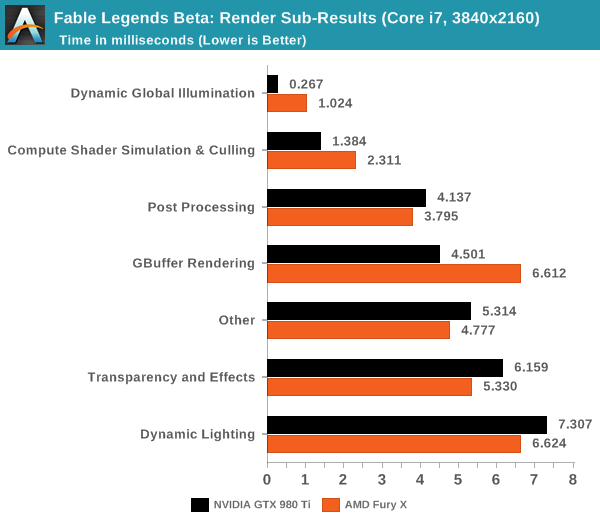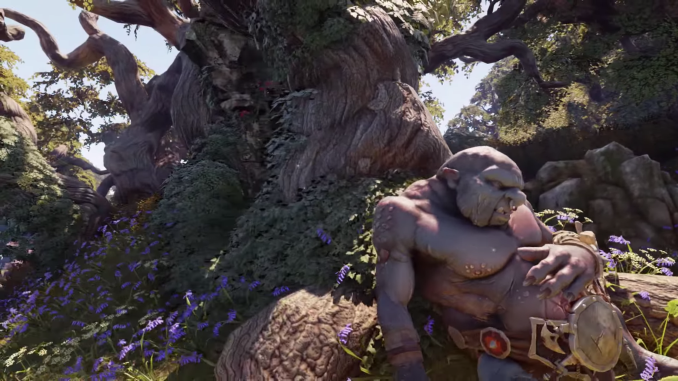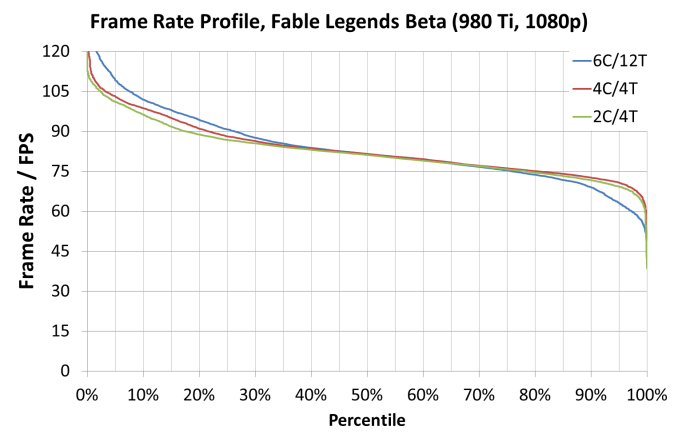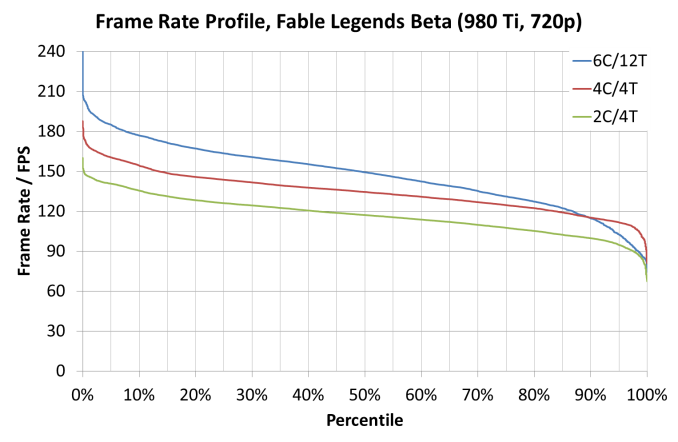Fable Legends Early Preview: DirectX 12 Benchmark Analysis
by Ryan Smith, Ian Cutress & Daniel Williams on September 24, 2015 9:00 AM ESTFinal Words
Non-final benchmarks are a tough element to define. On one hand, they do not show the full range of both performance and graphical enhancements and could be subject to critical rendering paths that cause performance issues. On the other side, they are near-final representations and aspirations of the game developers, with the game engine almost at the point of being comfortable. To say that a preview benchmark is somewhere from 50% to 90% representative of the final product is not much of a bold statement to make in these circumstances, but between those two numbers can be a world of difference.
Fable Legends, developed by Lionhead Studios and published by Microsoft, uses EPIC’s Unreal 4 engine. All the elements of that previous sentence have gravitas in the gaming industry: Fable is a well-known franchise, Lionhead is a successful game developer, Microsoft is Microsoft, and EPIC’s Unreal engines have powered triple-A gaming titles for the best part of two decades. With the right ingredients, therein lies the potential for that melt-in-the-mouth cake as long as the oven is set just right.
Convoluted cake metaphors aside, this article set out to test the new Fable Legends benchmark in DirectX 12. As it stands, the software build we received indicated that the benchmark and game is still in 'early access preview' mode, so improvements may happen down the line. Users are interested in how DX12 games will both perform and scale on different hardware and different settings, and we aimed to fill in some of those blanks today. We used several AMD and NVIDIA GPUs, mainly focusing on NVIDIA’s GTX 980 Ti and AMD’s Fury X, with Core i7-X (six cores with HyperThreading), Core i5 (quad core, no HT) and Core i3 (two cores, HT) system configurations. These two GPUs were also tested at 3840x2160 (4K) with Ultra settings, 1920x1080 with Ultra settings and 1280x720 with low settings.
On pure average frame rate numbers, we saw NVIDIA’s GTX 980 Ti by just under 10% in all configurations except for the 1280x720 settings which gave the Fury X a substantial (10%+ on i5 and i3) lead. Looking at CPU scaling, this showed that scaling only ever really occurred at the 1280x720 settings anyway, with both AMD and NVIDIA showing a 20-25% gain moving from a Core i3 to a Core i7. Some of the older cards showed a smaller 7% improvement over the same test.
Looking through the frame rate profile data, specifically looking for minimum benchmark percentile numbers, we saw an interesting correlation with using a Core i7 (six core, HT) platform and the frame rates on complex frames being beaten by the Core i5 and even the Core i3 setups, despite the fact that during the easier frames to compute the Core i7 performed better. In our graphs, it gave a tilted axis akin to a seesaw:
When comparing the separate compute profile time data provided by the benchmark, it showed that the Core i7 was taking longer for a few of the lighting techniques, perhaps relating to cache or scheduling issues either at the CPU end or the GPU end which was alleviated with fewer cores in the mix. This may come down to a memory controller not being bombarded with higher priority requests causing a shuffle in the data request queue.

When we do a direct comparison for AMD’s Fury X and NVIDIA’s GTX 980 Ti in the render sub-category results for 4K using a Core i7, both AMD and NVIDIA have their strong points in this benchmark. NVIDIA favors illumination, compute shader work and GBuffer rendering where AMD favors post processing, transparency and dynamic lighting.
DirectX 12 is coming in with new effects to make games look better with new features to allow developers to extract performance out of our hardware. Fable Legends uses EPIC’s Unreal Engine 4 with added effects and represents a multi-year effort to develop the engine around DX12's feature set and ultimately improve performance over DX11. With this benchmark we have begun to peek a little in to what actual graphics performance in games might be like, and if DX12 benefits users on low powered CPUs or high-end GPUs more. That being said, there is a good chance that the performance we’ve seen today will change by release due to driver updates and/or optimizing the game code. Nevertheless, at this point it does appear that a reasonably strong card such as the 290X or GTX 970 are needed to get a smooth 1080p experience (at Ultra settings) with this demo.














141 Comments
View All Comments
Gotpaidmuch - Thursday, September 24, 2015 - link
Sad day for all of us when even the small wins, that AMD gets, are omitted from the benchmarks.Oxford Guy - Thursday, September 24, 2015 - link
"we are waiting for a better time to test the Ashes of the Singularity benchmark"ZipSpeed - Thursday, September 24, 2015 - link
The 7970 sure has legs. Turn down the quality down one notch from ultra to high, and the card is still viable at 1080p gaming.looncraz - Thursday, September 24, 2015 - link
As a long-time multi-CPU/threaded software developer AMD's results show one thing quite clearly: they have some unwanted lock contention in their current driver.As soon as that is resolved, we should see a decent improvement for AMD.
On another note, am I the only one that noticed how much the 290X jumped compared to the rest of the lineup?!
Does that put the 390X on par with the 980 for Direct X 12? That would be an interesting development.
mr_tawan - Thursday, September 24, 2015 - link
Well even if UE4 uses DX12, it would probably just a straight port from DX11 (rather than from XBONE or other console). The approach it uses maynot flavour AMD as much as Nvidia, who know ?Also I think the Nvidia people would have involved with the engine development more than AMD (due to its developer relationships team size I guess). The Oxide games also mentioned that they got this kind of involvement as well (even if the game is AMD title).
tipoo - Thursday, September 24, 2015 - link
Nice article. Looks like i3s are going to only get *more* feasible for gaming rigs under DX12. There's still the odd title that suffers without quads though, but most console ports at least should do fine.ThomasS31 - Thursday, September 24, 2015 - link
Still not a Game performance test... nor a CPU.There is no AI... and I guess a lot more is missing that would make a difference in CPU as well.
Though yeah... kind a funny that an i3 is "faster" than an i5/7 here. :)
Traciatim - Thursday, September 24, 2015 - link
This is what I was thinking too. I thought that DX12 might shake up the old rule of thumb saying 'i5 for gaming and i7 for working' but it seems to be this still holds true. In some cases it might even make more sense budget wise to go for a high end i3 and sink as much in to your video card as possible rather than go for an i5 depending on where your budget and current expected configuration are.More CPU benchmarking and DX12 benchmarks are needed of course, but it still looks like the design of machines isn't going to change all that much.
Margalus - Friday, September 25, 2015 - link
this test shows absolutely nothing about "gaming". It is strictly rendering. When it comes to "gaming" I believe your i3 is going to drop like a rock once it has to start dealing with AI and other "gaming" features. Try playing something like StarCraft or Civilization on your i3. I don't think it's going to cut the muster in the real world.joex4444 - Thursday, September 24, 2015 - link
As far as using X79 as the test platform here goes, I'm mildly curious what sort of effect the quad channel RAM had. Particularly with Core i3, most people pair that with 2x4GB of cheap DDR3 and won't be getting even half the memory bandwidth your test platform had available.Also fun would be to switch to X99 and test the Core i7-5960X, though dropping an E5-2687W in the X79 platform (hey, it *is* supported after all).